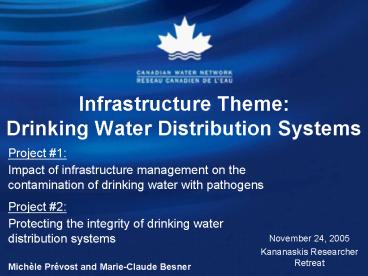Infrastructure Theme: Drinking Water Distribution Systems - PowerPoint PPT Presentation
1 / 12
Title:
Infrastructure Theme: Drinking Water Distribution Systems
Description:
Our investigation shows that main repairs affect water quality both inside and ... USEPA, as part of the TCR revision process, is writing a white paper based on ... – PowerPoint PPT presentation
Number of Views:511
Avg rating:3.0/5.0
Title: Infrastructure Theme: Drinking Water Distribution Systems
1
Infrastructure Theme Drinking Water
Distribution Systems
Project 1 Impact of infrastructure management
on the contamination of drinking water with
pathogens Project 2 Protecting the integrity of
drinking water distribution systems Michèle
Prévost and Marie-Claude Besner
- November 24, 2005
- Kananaskis Researcher Retreat
2
Overall Goal
- Determination of the likelihood of drinking water
DS contamination during normal operation and
determination of the risk associated with OM
activities
3
Research Team
- Key Participants
Project 1 (2002-2005)
Project 2 (2005-2007)
4
Key Challenges/Goals
- The Key Challenges Being Addressed by Our Team
are - What are the causes of non-compliance events in
DSs? - Do OM activities represent a significant risk of
contamination? - Controlled pump startup and shut down
- Opening/closing of fire hydrants or valves
- Flushing operations
- Repairs of pipeline breaks
- How are these activities related to the
occurrence of transient pressures? - How can DS design and operation be improved to
minimize the risk? - What are the economical impacts of repair works
and water contamination?
5
Relevant State-of-The-Research
- Waterborne disease outbreaks are caused by DS
deficiencies - Integrity of DS is key Payment studies on DS
- Ingress is possible in pressurized systems
- Contamination is possible during
repairs/replacement - Backflow prevention
- Pipe failures in ageing infrastructure are a
growing concern
6
Approach
- Study of the impact of infrastructure
operation/management on the contamination with
pathogens - Data mining
- Field samplings
- Study of the impact of transient low pressures on
pathogen intrusion
7
Stage of Research
- Main causes of non-compliance events have been
identified through the use of a data-mining
approach - Protocols for sampling during some OM activities
have been developed - Field investigations of OM activities are in
progress
8
Key Findings/Observations
- Our data mining approach
- showed that water quality problems could only be
explained by considering various types of data
(water quality, hydraulics, OM, system
structural characteristics, etc.) - This finding has been transposed in our field
studies by involving experts in all those fields.
The research team study the physical, hydraulic,
chemical and microbiological aspects of
distribution systems. - DS microbial water quality
- Although microbial regrowth was classically
associated with occurrence of non-compliance
events, we showed that OM activities in DSs
could be a significant cause of these events
9
Key Findings/Observations
- This is the first study providing actual data on
impact of main repairs. Our investigation shows
that main repairs affect water quality both
inside and outside the repair area - Our field investigation methodology led to the
first demonstration of actual contaminant
intrusion of microbial indicators into a full
scale distribution system, during pipe repair
work.
10
Insights on Knowledge Transfer
- The paper Explaining the occurrence of coliforms
in DSs by Besner et al. (J. AWWA, 2002, 948.
95-109) was granted the 2004 AWWA Distribution
Plant Operations Best Paper Award - The data mining approach (and software) developed
is being applied in a number of European
utilities managed by Veolia Water - USEPA, as part of the TCR revision process, is
writing a white paper based on our results of
causes of non-compliance events - The 2004 AWWA WQTC presentation on field
investigation of repairs led to the invitation of
M-C Besner to a 1-day workshop on Pipeline
repair/replacement practices and their
relationship to water quality at the 2005 AWWA
DSS Conference
11
Opportunities
- Complete project to get insights into
- Impact of pipe flushing
- Impact of pump operation in rural system
- Risk analysis framework
- Economic analysis of impacts of repair works
12
Collaborative Interests
- Development of data mining approaches
- Risk analysis approaches for determining risks
related to DSs - Epidemiological studies
- Advanced microbial detection methods

